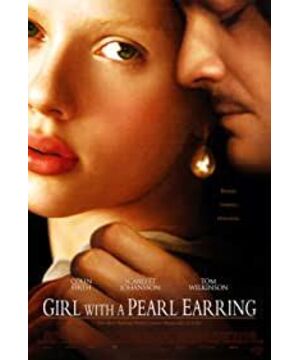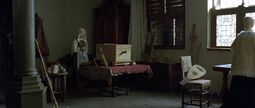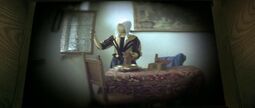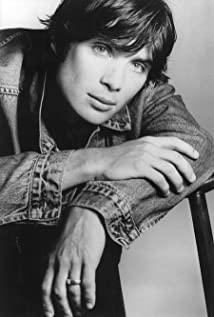Vermeer Johannes (1632-1675) lived in the small town of Delft in the Netherlands. Before his death, he was unknown and had little biographical information. He was rediscovered two centuries later and was called "the Sphinx who slept for two centuries." s” .
He only has less than 40 paintings handed down, and he has a unique use of light and color. He is known as the "Master of Light" and "Master of Color", and he is also known as the "Three Masters of the Netherlands" together with Hals and Rembrandt.
Chevrolet, an American female writer, saw her painting "Girl with a Pearl Earring" and was inspired to create a novel of the same name.
The novel is narrated from a first-person omniscient perspective, with 1664, 1665, 1666, and 1676 as the retrospective points. It is a female monologue novel with a linear narrative.
As a movie, the director carefully designed many close-up shots and subjective shots of the heroine, and the slow close-up and long shots showed the inner activities of the girl to the greatest possible extent.
The film integrates a large number of painting arts of the Dutch small school, and has won the essence of painting art and film art, and creatively realizes the perfect grafting of the two arts.
The film is beautiful and delicate, every shot is meticulously crafted, the rhythm is soothing and the charm is long, with a subtle and elegant oriental charm and screen poetic beauty.
"Girl with a Pearl", as director Peter Weber's debut, received rave reviews as soon as it came out, winning three nominations for Best Art Direction, Best Cinematography, and Best Costume Design at the 76th Academy Awards and the 61st Academy Awards. Golden Globe nominations and many other awards.
Film history relies on the continuous transformation of images to express ideas, and "Girl with a Pearl Earring", as an art film, uses light and shadow art to the extreme, and the time and space scenes are all based on the street and courtyard scenes of Vermeer's life, maintaining the Considerable overlap with reality.
The painting "Girl with a Pearl Earring" was created by Vermeer in 1665 on a canvas of only 46x40cm.
Two centuries later, it crossed time and space and broke national boundaries, attracting a large number of artists and critics to stop and nostalgic.
From Vermeer's paintings, to Chevrolet's novels, to Peter Weber's film adaptations, the three-story narrative brings together artists' keen capture of "instant beauty."
The whole film is like a long scroll of Baroque art, which combines the aesthetic expressions of different media forms of painting and novels, and presents the ultimate picture of artistic beauty.
The beauty of light and shadow and painting
Every sub-shot of the film has the artistic beauty of Baroque oil painting.
At the beginning of the film, the picture dissolves from the middle, and several large close-up shots show the juicy red, white and green vegetables, and the fresh and juicy cabbage can be felt.
Then, a set of long shots are used, and the shots are slowly pulled back, from close-up to medium shot to panorama, gradually showing the focused expression of the heroine Gree, and the camera is gradually pushed forward to the close-up of the character, presenting a simple and gloomy kitchen in terms of narrative function. The background sets the aesthetic subtle style and lyrical poetic tone for the whole film.
At the same time, the oil painting-like depth of field and dark background are very painterly.
Then use two sets of back shots to enter the narrative, showing a brief dialogue with his parents, explaining that his father was a tile painter who was blinded in an accident, and the family was in a dilemma of starvation. Artistic talent.
This kind of skillful transition of large close-up and large panorama without leaving traces brings the film's narration language clear and bright.
In order to show the delicate texture of Baroque painting, the director selected the typical elements of Baroque art, and skillfully weave these elements into a tight narrative state.
At the same time, the light and shadow technology and tone structure of multiple brightness systems are used to present the texture and color of different scenes and different scenery, so as to achieve a delicate and perceptible screen modeling effect.
Recreate the interior structure and still life of Vermeer's studio through the subjective perspective of the girl Greeting and the slow panning lens;
A fast-moving aerial shot of classic baroque art elements such as metal cutlery, gold and silver utensils, clear glasses, and polished candlestick china is showcased through the celebration of a new baby and new work "Woman Dressing Up With a Pearl Necklace" ;
The outdoor scenery, street scenes and courtyard daily life scenes of Delft in the 17th century are displayed through the lens of panoramic and close-up shots. Natural light effects and double-layer filters create a beautiful oil painting-like beauty.
The film uses a montage technique to show the background of time and space, and restores the cleanest city in Europe that "has not changed in four hundred years" according to Vermeer's "Landscape of Delft".
Out of the needs of the narrative function, the empty lens objectively explains the time and space background, providing a clear sense of time and space for the narrative.
Stone bridges and churches are important cultural elements. Gree (Scarlett Johansson) arrives and leaves through the stone bridge, delivers letters and worships, and the reproduction of montage creates a strong viewing effect and visual experience.
The effect of soft light shrouding creates a delicate and soft scene and visual perception, and the whole film is like a collection of oil paintings on coated paper. The language of the lens is clear and simple, very delicate and rich in texture.
Aesthetic and emotional factors are usually added to the light perception of the pictures in the film, and different lighting methods result in unique tonal perspective and tonal perspective.
Greeting and Pete (Cillian Murphy) are lovers walking outdoors. In the spring scene, the picture is bright and close to natural light, while the snow scene uses a large amount of scattered light reflected from the ground snowflakes to bounce upward, and use a color filter to add warm yellow to fill the atmosphere. Between and diffuse across the frame, creating a beautiful soft warm yellow tone.
The characters and trees are also dyed with a layer of romantic and warm warm colors in winter. Although the ground is covered with frost and snow, there is no sense of cold and bleak. It accurately presents the sense of place and time in the space, the happy emotions of the characters, the sweetness of love and sweetness. The emotional state and the warmth of happiness are very expressive.
At the same time, the reshaping effect of light makes the beauty and texture of the girl's screen shape sublime.
In the history of Western art, the motif of Venus, the god of love and beauty, has been loved and favored by artists of all dynasties. In the film, multiple side-reclining scenes are set up for girls, which is intertextual with the motif of "Venus" in Western art. Sex is present immediately.
In the scene where the girl Greet is resting in the cellar, the director uses light as a brush, and the white side backlight scatters to hit the costume and the side face, highlighting the character from the dark and dark background, the soft texture of the clothes, the smooth texture of the skin Bring a soft and soft visual experience.
The white robe only showed light at the elbows and the head scarf, and the white halo was like the clothes itself, which further set off the smoothness of the skin, which was solemn and gentle.
Scarlett Johansson's forbearance and peaceful expression and graceful facial contours and lines express the girl's innocence, inner tranquility and spiritual nobility quite vividly.
The girl's screen shape is beautiful and elegant, like a goddess lying on her side, sacred and solemn, with a sculptural sense of dignity and eternity.
This kind of large light ratio picture mainly formed by gray, white and black and cold tones, strong tonal contrast and light and dark configuration, and the presentation of stage-style lighting pictures all reflect the artistic characteristics of Baroque painting, showing the heroine Gree. The awe-inspiring elegance and noble spirit in the arduous labor and repressed living conditions.
The beautiful intersection of lens and narrative
The lens is the carrier of film language.
The film selects the poetic structure that is most suitable for art films. It does not win with the complexity of the plot, but has clear and clear narrative clues and structures.
The narrative clues of the film are in a three-dimensional cross-network structure, with the girl Gree as the center, forming a network-like cross structure with multiple functional characters.
The various clues are interspersed and intersected, and the narrative function of the lens language is flexible and ingenious.
Use a contrasting montage to highlight two main narrative threads:
One is the growing estrangement between Vermeer and his wife (Ess Davis), and the other is that they are in harmony with Greet's artistic inspiration.
The two clues contrast each other to develop the narrative.
Scene switching is mostly a direct jump and transition, directly switching from a slow indoor scene to an outdoor high-brightness panorama, long-range series of scene shots, and using large jumps one after another, which is very characteristic of visual changes.
This visual change rhythm is both a spatial relationship and a psychological relationship, which brings a sharp visual impact and a strong psychological feeling while increasing the narrative capacity.
At the same time, it is adopted to make the picture and dialogue do not connect, increase the narrative capacity, and highlight the results of audio-visual comparison.
Among them, the scene of servants and children eating in the kitchen, the atmosphere is harmonious and harmonious, the scene is beautiful and quiet like an oil painting, but the sound effect is set to the voice-over of the hostess complaining and scolding:
"Seeing your wife, ragged children, starving and freezing, still playing with your broken paintbrush..."
The emotions expressed by the picture and the sound are completely opposite but deliberately combined, which clearly reinforces the bitterness and inhumanity of the hostess and the inevitable family conflicts.
The family conflict has been downplayed behind the scenes until the conflict in the final scene reaches its climax, showing the hysterical questioning of the hostess through the tense scheduling of the four characters.
When the girl was rudely reprimanded by the hostess and left, she looked sideways at the hostess and walked slowly but firmly towards the camera from the background. It was the only time in the whole play that she left without luggage, which alludes to the noble personality of the girl and the ruthlessness of the hostess.
The director uses the method of accumulation montage to move the conflict from outside the screen into the front of the camera, so the narrative throughout is ingenious, so it is extremely explosive and infectious at the apex.
The tailoring of the structure reflects the deep grasp of the lens language on the narrative function of novels and paintings, while the sound effects subtly render and deepen the poetic narrative of the film.
The melodious acoustic music played by the classical string piano, using music to reproduce montage, appears repeatedly at the beginning and end of the film as well as in the middle plot.
Alexandre Despla's custom-made soundtrack for the film is graceful and elegant, with gentle and euphemism in the torrents.
It was nominated for both the Golden Globe and the British Film Institute's Best Soundtrack Award that year.
There are few lines in the film, but every word is eloquent, and the sound atmosphere of the whole film is quite quiet and tense.
The host Vermeer (Colin Firth) quietly paints and meditates, making paints, and the maids are busy in the kitchen or courtyard;
The exterior scene is a river passing through the city, frozen or thawed, and the seasons change in winter, spring, summer and autumn. In the quiet sound atmosphere, it highlights the clear sense of time and space of the alternation of seasons and the change of day and night.
The noise in the market is blurred and distant, which reduces the hardness of the sound and creates a soft and gentle tone of hearing.
In addition, the heavy sound of wooden doors and windows opening and closing, the tapping of footsteps and the floor, the rustling of pearls colliding, the rubbing sound of the knife plate, and even the breathing of the characters in the close-up shots are full and clear. The sound is different. The texture is audible.
Rhythm is an important means of expressing and transmitting emotions.
The unhurried editing results in the overall slow and lyrical rhythm of the music and narrative, which has the subtle beauty of oriental freehand aesthetics.
In addition to borrowing the light and shadow skills of Baroque painting art, the director skillfully controls the narrative and freehand functions of empty shots and close-ups, and skillfully integrates many Baroque art paintings involved in the narrative into the visual change flow of the film's narrative.
Shadow and painting are intertwined.
The courtyard of Vermeer's house, which appeared in the film, reproduces "The Courtyard of Delft" by Peter de Hooch, who is also a Dutch painter.
In the scene of delivering the letter, a deep focus lens is used. The foreground is a close-up shot of a young girl Greer with her head bowed shyly. The use of filter technology softens the light perception of the picture, and the look is soft and delicate.
Vermeer oil painting Delft View
The director's ingenuity is to highlight the characters' sense of insignificance and helplessness in time and space. The subjective meaning is to throw out the fate of the characters, and it also implies that the insignificance of his own power will eventually be broken by the god of fate, resulting in a sad and emotional viewing. Effect.
In addition, set the businessman identity in "The Woman Holding the Wine Glass" as the sponsor Van Lavin (played by Tom Wilkinson), with a very precise line: "The wine is shining in the glass, and I want to reach out and touch it. This satin" to point out the greatest feature and core artistic charm of Baroque art.
The birthday party was full of friends, and the close-up shot was "Woman Dressing Up With a Pearl Necklace". The main color was warm yellow, "the perspective of the picture is accurate, and the color is impeccable" , and the identity of the woman in the painting was set as the sponsor's wife.
Greet's cleaning of the windows inspired the painter to create "Woman with a Water Bottle", and "Concert" at the request of the sponsor.
As the film suggests, Vermeer uses a balanced composition, a clear sense of spatial order and a harmonious dark configuration, in harmony with pearl-like highlights, to form a calm and peaceful meaning, eternal poetry and eternal appeal.
The screen space display of Baroque art is not only the focus of narrative, but also contains a lot of professional knowledge of art history and painting art.
Narrative elements and freehand elements are displayed side by side, and the rhythm is relaxed and intertwined, and the visual changes brought about by it create a spiritual satisfaction of soaring and leaping and a psychological experience of intoxication and sublimation.
Screen Reproduction of Art Classics
It was quite challenging for a director to choose a re-adaptation of a novel that combines well-known paintings and great achievements.
Without a large amount of accurate and appropriate art history knowledge as a strong support, it can only face the embarrassment of fragmented narrative and the theoretical scrutiny that is stretched.
The film crew led by Peter Weber, who is familiar with historical themes, undoubtedly has profound artistic accomplishment and keen observation, and is well versed in the core artistic charm of various themes of art, literature and film.
The perfect artistic details of the film are everywhere without a deep grasp of the historical facts of art.
As shown in the film: the artist makes his own paint, and the original paint has to be purchased from a pharmacist in a drugstore; the painting leaves the church and the regime and enters the bourgeoisie, and the artist needs the financial support of the patron to survive, so the film The middle-wealthy businessman Van Lavin was able to so arrogantly declare that "he must paint according to my liking."
The most important thing is that the film lightly demonstrates Vermeer's most acclaimed superb skills, that is, the use of light and color, to de-charm the "Master of Light" and "Master of Color".
Most of Vermeer's works usually use the side backlight of the right side window of the studio, so he is called "window painter".
It has been proved that Vermeer did use the "obscacle technique" for optical experimental creation earlier, and used stippling and highlight techniques in his works.
The scene where the color of clouds is discussed in the film is an illustration of Vermeer's multi-layer painting technique.
That is, the base color is applied first, then the base color and normal color are used, and finally a clear coating is applied, and the colors of each layer penetrate each other.
Therefore, the two primary colors of higher purity and lightness, yellow and blue (yellow and blue are the most favorite colors of Vermeer), have a large contrast but can be harmoniously blended, so that the painting presents a peaceful and delicate gorgeous light.
With his precise observation and expressiveness, clear and powerful perspective, and delicate brushstrokes, Vermeer has upgraded inner peace and elegant pursuit of art into delicate and gorgeous classics.
The film is 100 minutes long. At 65 minutes, the girl's shape begins to be brewed. The director uses more than one-third of the length to build momentum and spare no effort.
Near the end of the film, a 90-second long shot and close-up of the "Girl with a Pearl Earring" on-screen look is the ultimate presentation.
First of all, the screen is dark, and then it dissolves in from the center. First, a large close-up of the pearl earring in the high-light part is shown. The camera is slowly pulled back, and the whole face close-up gradually appears, and then the whole frame is presented and stopped.
The composition of the original picture of "Girl with a Pearl Earring" is a girl with bright eyes and white teeth looking back. A glance back is a subtle capture of the momentary interest, which contains endless beauty and eternal artistic vitality.
The film footage and the original painting maintain a large degree of overlap.
The background of the picture is designed to be dark and black, using the stippling method, light spots, and a fine music rhythm, resulting in a deep sense of the picture space.
The distant view is filled with color, like a starry sky, which highlights the vastness of the background, and at the same time brings out the delicate and soft outline of the girl, creating a dynamic effect of walking towards the depth of the field.
The black and white highlights at the eyes, the red highlights on the lips, and the pearl highlights hanging on the ears form a triangular composition, making the composition balanced and stable.
Shark-like pearl light embellishes the center, which balances the picture and composition, and has a unique sense of gorgeous light.
The girl looks back, the twisting action is shown by the shadow, the shadow on the neck makes the outline of the portrait more soft, and at the same time activates the picture, making the picture appear agile and giving the picture a sense of vigor.
Neck twisting, pursing lips, opening lips, these subtle but pivotal modeling movements are presented in the film with facial close-up shots, which is not only the artist's ultimate pursuit of perfect art, but also the film team's keen observation and perfect presentation of the details of the meridians.
The scene at the end of the movie is presented from the left, showing the lonely and lonely back of a shallow and frivolous wealthy businessman. All worldly desires vanished without a trace in front of such pure and pure beauty.
The true identity of the girl in the painting is like the mystery of the identity of the "Mona Lisa", and we have no way of knowing it.
However, such defects and unconscious blanks have become "Broken Arm Venus", which adds to the mystery of the painting and the artistic reverie of art critics. The Dutch art critic Goschjerde called the girl in the painting "the Mona of the North." Lisa".
Vermeer's finishing touch endows the pure beauty with a sense of eternity, making this mysterious woman transcend time and space to reach immortality, transcend ordinary human nature to reach divinity.
Vermeer's "Girl with a Pearl Earring" is a treasure of the Mauritshuis Royal Museum of Fine Arts in The Hague, which is in permanent collection and is no longer on loan.
Before countless people stopped and lingered in front of the small picture, the "Painting Version of Beauty God Venus" was silent and indifferent, but it was interpreting the immortality of art and the eternity of beauty.
Vermeer's screen appearances, which are shown in backlit silhouettes and silhouetted silhouettes many times in the film, are a metaphor for the artist's solitary and quiet style and the exhaustion of artistic creation.
The artistic vitality contained in the many artistic elements and visual language of the film's screen narrative space is indeed the ultimate interpretation of the artist's self-sufficiency, peaceful personality and artistic inspiration.
As the film shows, this is Vermeer's greatest artistic charm.
View more about Girl with a Pearl Earring reviews











